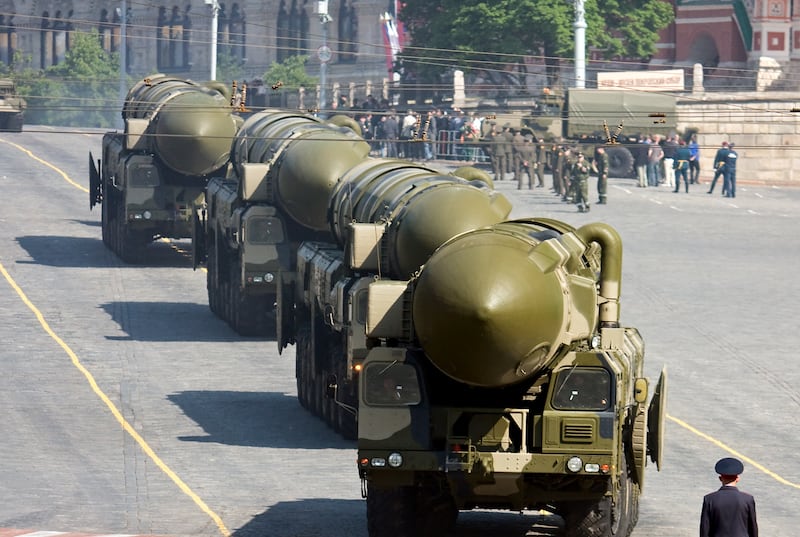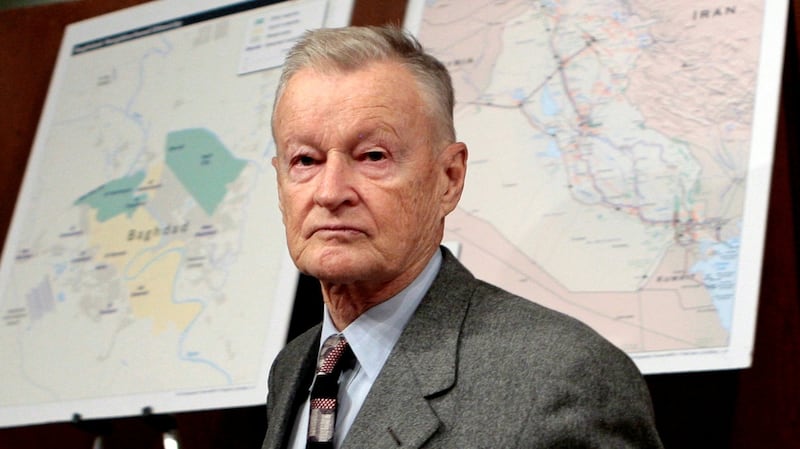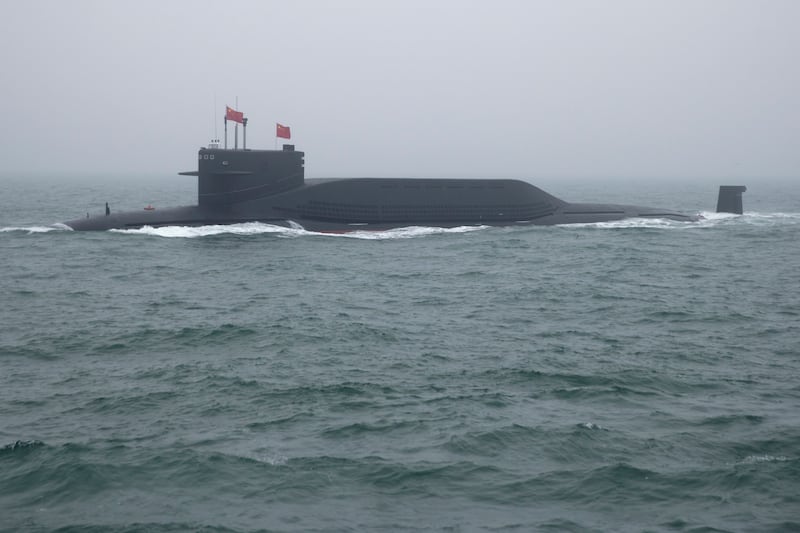When I was a child in the 1980s, I was pretty sure I was going to die in a nuclear war. We were living in the shadow of “mutually assured destruction” with the US and the then Soviet Union pointing tens of thousands of warheads at one another and everyone else destined to die in the fallout or the starvation of a nuclear winter.
I read post-nuclear war set books such as Z for Zachariah by Robert C O’Brien, Brother in the Land by Robert Swindells and When the Wind Blows by Raymond Briggs. About half of the stories in my favourite comic 2000AD were set in a post-nuclear wasteland. On television, films such as The Day After and Threads tried to dramatise the horrific reality of nuclear war.
Nowadays, there are fewer nuclear warheads but there are still enough to destroy all human life. The International Campaign to Abolish Nuclear Weapons contends that 0.1 per cent of the world’s arsenal would cause “devastating agricultural collapse and widespread famine”. There are currently nine countries with nuclear weapons. The US has 5,748. Russia has 5,580. China has around 500. Vladimir Putin has recently suggested that Russia would respond with nuclear weapons to any “critical threat to [its] sovereignty.”
Israel (90 warheads), another nuclear power, has been responding militarily to an aspiring one, Iran. A recent academic study suggested a nuclear exchange just between India (172 warheads) and Pakistan (170 warheads) could kill more than two billion people. The UK (225), France (290) and North Korea (50) are the other countries with nuclear arms.

In 2013, I interviewed American author Eric Schlosser about his book Command and Control: Nuclear Weapons, the Damascus Incident and the Illusion of Safety, in which he wrote about times when the world came to the brink of nuclear destruction.
Speaking to him again recently over the phone from the US, he says that “when I wrote the book, I was concerned. I felt this was a threat that had been largely forgotten.”
And now?
“I am deeply concerned,” he says. “We’re in uncharted territory with a multipolar nuclear arms race. The one between the United States and Soviet Union almost seems simple and quaint in retrospect. It’s so much more complex when you have China, the United States and Russia engaging in a nuclear arms race, plus India and Pakistan, plus North Korea destabilising things.”
Alexander Glaser is a Princeton university professor and the winner of the American Physical Society’s 2025 Leo Szilard Lectureship Award for contributions to advance nuclear arms control, non-proliferation and disarmament verification. “The absolute number [of warheads] are lower but that doesn’t actually matter all that much,” says Glasser. “They’re much more accurate today. They’re much more reliable in terms of the capability to destroy targets in another country.”
Glaser is on the science and security board of the Bulletin of Atomic Scientists which sets the Doomsday Clock. This is the metaphorical device used to gauge the existential threat of nuclear destruction (and also the existential threat of climate change and biotechnology). When it was established in 1947 in the aftermath of the Hiroshima and Nagasaki bombings it was set at seven minutes to midnight. The safest period in nuclear weapon history was in 1991 when it was set to 17 minutes to midnight. It has been, since January 2023, 90 seconds to midnight.
I really hope we can get arms control and disarmament without nuclear weapons ever being used again
What happened since the optimistic 1990s? Nuclear disarmament was on the global agenda then, says Glaser (he’s speaking, he stresses, on his own behalf, not for the Bulletin of Atomic Scientists). “But 9/11 threw a wrench into this process, because suddenly attention shifted to nuclear terrorism. In 2002, the US withdrew from the antiballistic missile treaty. Moscow was very unhappy about this ... We’re paying the price right now. The fact that Russia built all these new weapon systems goes back to 2002.”
In 2019, the INF (Intermediate-Range Nuclear-Forces) Treaty collapsed. In 2023 the Russian federation suspended its participation in the Treaty on Measures for the Further Reduction and Limitation of Strategic Offensive Arms. “Even in the 1980s they talked to each other,” says Glaser.
Many policymakers during the Cold War accepted that there was no “winning” a nuclear war. They saw nuclear weapons as a deterrent. Some still believe that the fear of “mutually assured destruction” stopped a conventional war between the US and the Soviet Union. But the problem with using it as a deterrent, says Schlosser, “is that it works until it doesn’t”.

As he recounts in Command and Control, there was more than one time when an all-out nuclear assault was almost caused by a technical malfunction. In June 1980, for example, Jimmy Carter’s national security adviser, Zbigniew Brzezinski, was woken to be told that 22,000 warheads had been launched at the US. We’re all still here because they discovered a defective computer chip in the detection system before they retaliated. Brzezinski had already decided not to wake his wife so she could die in her sleep.
“We were lucky,” says Schlosser. “The generals and the weapons scientists I interviewed, they all were amazed that no city has been destroyed by a nuclear weapon since Nagasaki. They were amazed that we got out of the Cold War without a deliberate use of nuclear weapons or an accidental detonation.”
Now, he says, in a new era of nationalist exceptionalism, thousands of these weapons are still active. “If I were to hear tomorrow afternoon that a nuclear weapon had been detonated, it wouldn’t be shocking. It would make total sense.”
Modern technology doesn’t necessarily improve the picture. “There are people in the United States who are arguing that we should be incorporating artificial intelligence into nuclear command and control.” He laughs darkly.
“What could possibly go wrong?”
Nowadays, the situation is more geopolitically complex and it’s hard to predict if a single nuclear strike would lead to more. “In 1980s it was clear it would be an all-out global thermonuclear war,” says Glaser. “Today it’s not clear how far it would escalate or how quickly it could escalate if a single nuclear weapon was used on a Ukrainian city. It’s very difficult to think about these things, because, quite frankly, no one fully understands what a world would look like where a nuclear weapon has been used for the first time since 1945.”
Schlosser says one strike could conceivably lead to panicked responses. “Iran attacked Israel a month ago and it took Israel a month to calibrate its response. That’s not how a nuclear war would probably unfold. The logic of a nuclear war is hit first because whoever hits first has a huge advantage ... There’s a real pressure to act fast. So maybe one weapon would be detonated and that would be it, or maybe that would lead to hundreds of weapons detonated.”
The general push for disarmament seems to have reversed. “Now every nuclear weapons state is essentially modernising their entire weapon complex for the first time since the end of the Cold War,” says Glaser. “The US is investing $1.7 trillion in modernising the nuclear triad – the submarines, the bombers and the land-based missiles.”

Schlosser points to China. “China’s nuclear arsenal is growing at the fastest rate of any nuclear arsenal in the world. And with Russia making nuclear threats, in combination with its invasion of Ukraine, that’s put a lot of American policymakers in a difficult position ... How do you maintain the deterrents in a multipolar world with lots of countries getting nuclear weapons and now threatening to use them?”
Experts such as Glaser want countries to, at the very least, adopt a “no first use” policy. “The US does not have a ‘no first use’ policy,” he says. “This is basically a relic from the Cold War when the Soviets were much stronger on the conventional side, so the argument was, ‘We can’t really promise that we won’t use nuclear weapons first’. If every nuclear weapons state would declare a ‘no first use’ policy, then no one would be able to ever use them.”
In the meantime, non-nuclear countries are considering their options. “I was recently with a brilliant grad student in national security policy from South Korea, who said all of her friends want South Korea to have their own nuclear weapons,” says Schlosser. “After Trump’s presidency they don’t totally trust that the US would come to South Korea’s aid if North Korea used a nuclear weapon. If Trump is re-elected, there’ll be a number of countries that may think it’s in their interest to have their own nuclear arsenals. And the more countries that have nuclear weapons, the more likely at some point one is going to be used. Or two. Or 10.”
The problem right now is that despite the ongoing risk there isn’t the same popular understanding of the nuclear threat. This year, Stanley Kubrick’s nuclear war satire Dr Strangelove has been revived as a theatrical show. Oppenheimer – the story of the creation of the bomb – was one of the biggest films of 2023. But these are presented, ultimately, as period pieces.
“When I was in college in the ‘80s, we worried that we might die any day,” says Schlosser. “Everybody knew about the threat of nuclear war. In 1982 there was a demonstration against nuclear weapons in Central Park that was the largest political demonstration in American history up to that point ... There were demonstrations throughout the western world.”
Glaser worries that a popular disarmament movement might only arise after a nuclear weapon is used once more. “It would be tragic if that’s the price you would have to pay,” he says. “I really hope we can get arms control and disarmament without nuclear weapons ever being used again.”
- Sign up for push alerts and have the best news, analysis and comment delivered directly to your phone
- Join The Irish Times on WhatsApp and stay up to date
- Listen to our Inside Politics podcast for the best political chat and analysis

















